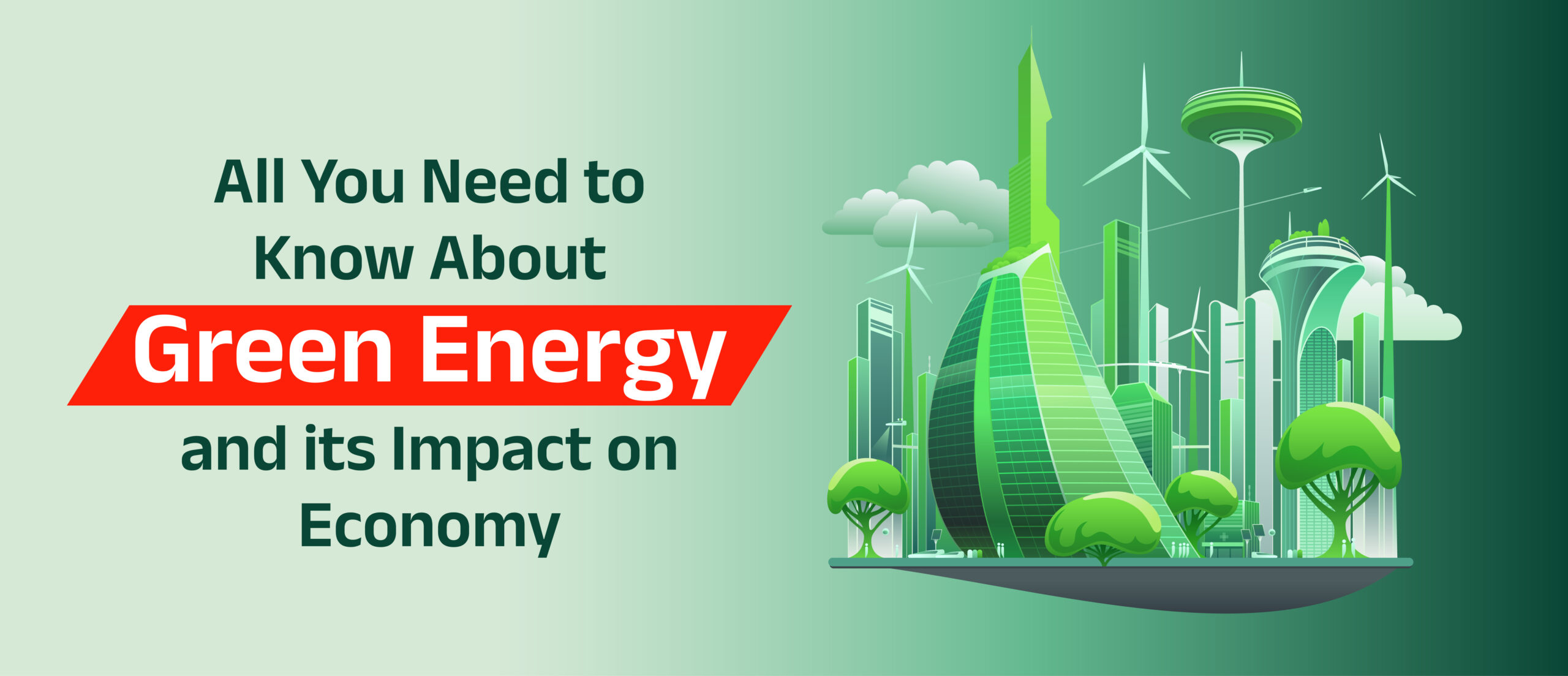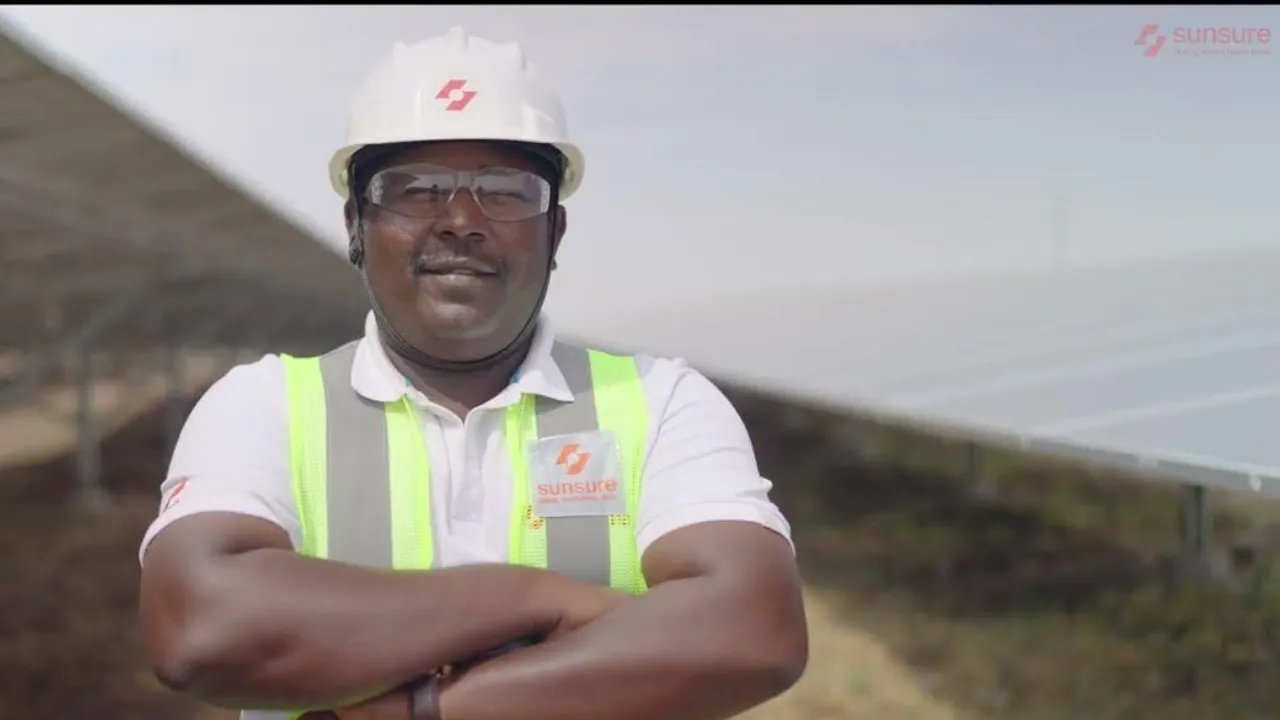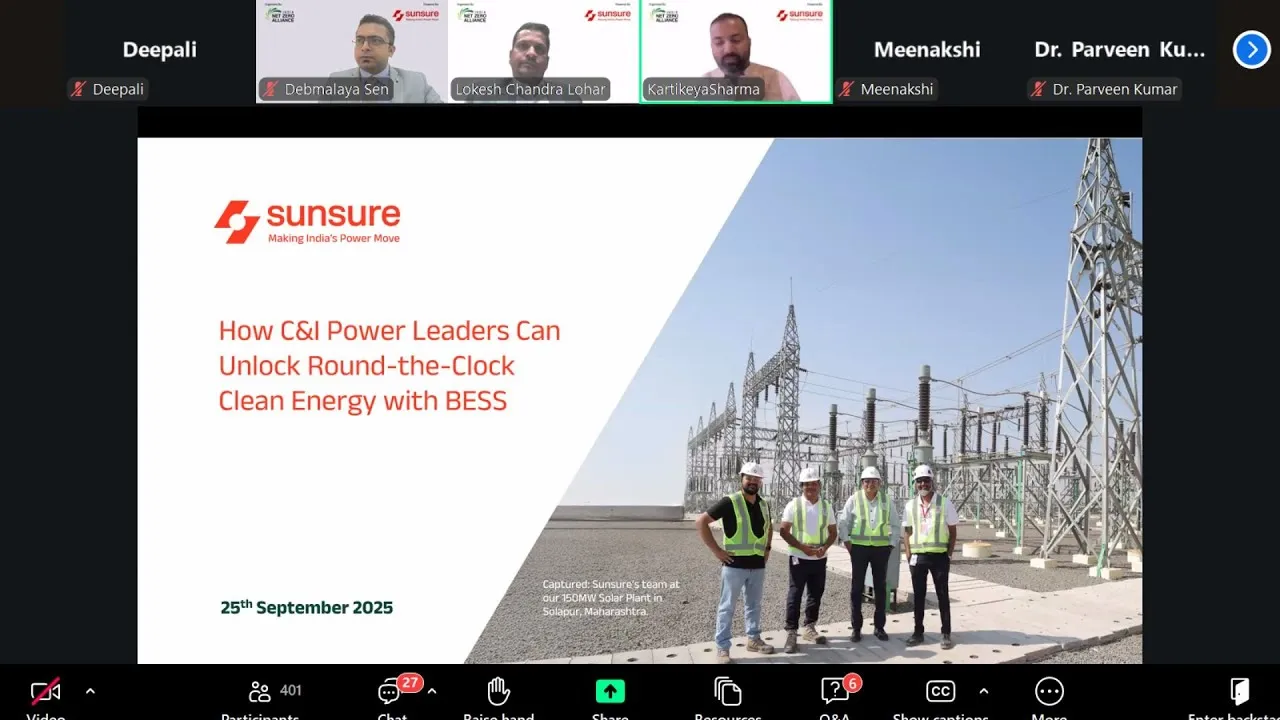India’s electricity consumption has consistently increased over the past decades, reaching 1,407 terawatt-hours in 2023. The industrial sector was the largest consumer of electricity, followed by households.
For a long time, most of India’s energy came from burning coal and other fossil fuels, which pollute the air and harm the environment. But now, India is turning to green energy sources like solar, wind, and hydropower.
These green renewable energy sources do not run out and help keep the air clean. The government and private companies are working together to increase the use of green energy. New technologies, financial support, and better policies are making it easier for businesses and homes to switch to renewable power.
What is Green Energy?
Green energy is a type of energy that comes from renewable energy sources like the sun, wind, and water. It does not harm the environment because it does not produce pollution or release harmful greenhouse gases. Green energy is renewable as it never runs out, but not all renewable energy is green.
For example, burning wood from trees is renewable but not always green because it creates smoke and carbon dioxide. Green energy helps reduce the use of coal and gas, which take millions of years to form and cause pollution while burning.
The common types of green energy include solar power, wind power, and hydroelectric power, which use sunlight, wind, and flowing water to create electricity safely.
What are the Different Types of Green Energy Sources?
Green energy comes from natural sources like the sun, wind, and water. Some types of green energy can be used at home, while others are produced in large power plants. The six main types are:
Green solar energy comes from the sun. Special panels called photovoltaic cells capture sunlight and turn it into electricity. Solar power can also be used for heating, cooking, and lighting homes. It is becoming the most affordable type of green energy and is used in small homes, commercial spaces, industry and big power plants.
Wind energy comes from moving air. Large wind turbines spin when the wind blows, creating electricity through an electric generator in the wind mill. Wind farms are built in open areas, especially offshore and on hills, where the wind is strong.
Hydropower, or hydroelectric energy, comes from moving water in rivers, dams, and tides. The water turns turbines to generate electricity. Even small water flows, like in-home pipes, can create energy.
Geothermal energy comes from heat stored under the Earth’s surface. It can be used to make steam that turns turbines to generate electricity. Some places, like Iceland, have easy access to this energy.
Biomass energy comes from burning natural waste like wood, sawdust, and farm leftovers. It produces some pollution but is cleaner than burning coal or gas.
What is the Difference Between Renewable, Clean, and Green Energy?
It is important to understand the difference between renewable, clean, and green energy to become more eco-friendly. The differences are:
| Factors |
Renewable Energy |
Clean Energy |
Green Energy |
| Definition |
Comes from sources that never run out, like the Sun, wind, and water. |
Does not create pollution or harmful gases. |
Comes from nature and does not harm the environment. |
| Example |
Solar Power, Wind Power, Hydro Power |
Wind Power, Solar Power, Nuclear Power |
Wind Power, Solar Power, Tidal Energy |
| Is it Always Green? |
Not always. Some hydropower plants do harm the environment. |
Some energy sources are clean but may not be fully green. |
Green energy is always good for nature. |
| Is it Always Clean? |
Some renewable sources of energy do create pollution. |
Clean energy does not pollute. |
Green energy also does not cause any pollution. |
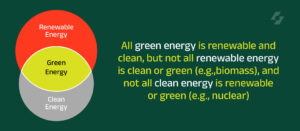
Points to Remember
Though there is a very thin line between them and they are often used interchangeably, some points to remember are:
- All green energy is clean, but not all clean energy is green. For example, nuclear energy is clean but isn’t green.
- All green energy is renewable, but not all renewable energy is green. Example, biomass is renewable, but not green.
- Wind and solar power are the best clean, renewable, and green energy examples.
Green Energy Technology: Innovations Driving the Future Businesses
Green energy technology is making our world cleaner and better. Scientists and engineers are working on new ideas to help us use energy without harming nature. Some exciting innovations are:
- Floating Solar Panels: Instead of taking up land, solar panels can now float on lakes, rivers, and dams. This saves space and keeps the panels cool, making them work better.
- Biodiesel Trains: Some trains in India now run on biodiesel, a fuel made from plants and organic waste. This helps reduce pollution from regular diesel engines.
- Concentrated Solar Power (CSP): This technology uses mirrors and lenses to focus sunlight, creating heat that turns turbines to generate electricity. It even works on cloudy days.
- Hydrogen Energy: Hydrogen is a clean fuel that does not create pollution. India plans to produce a lot of green hydrogen to replace fossil fuels in the future.
- Better Batteries: Lithium batteries are used in electric vehicles (EVs), but lithium is running out. New batteries made from aluminium and other materials charge faster and last longer.
Geothermal Energy: Ladakh is building India’s first geothermal project, which will use heat from deep inside the Earth to generate electricity.
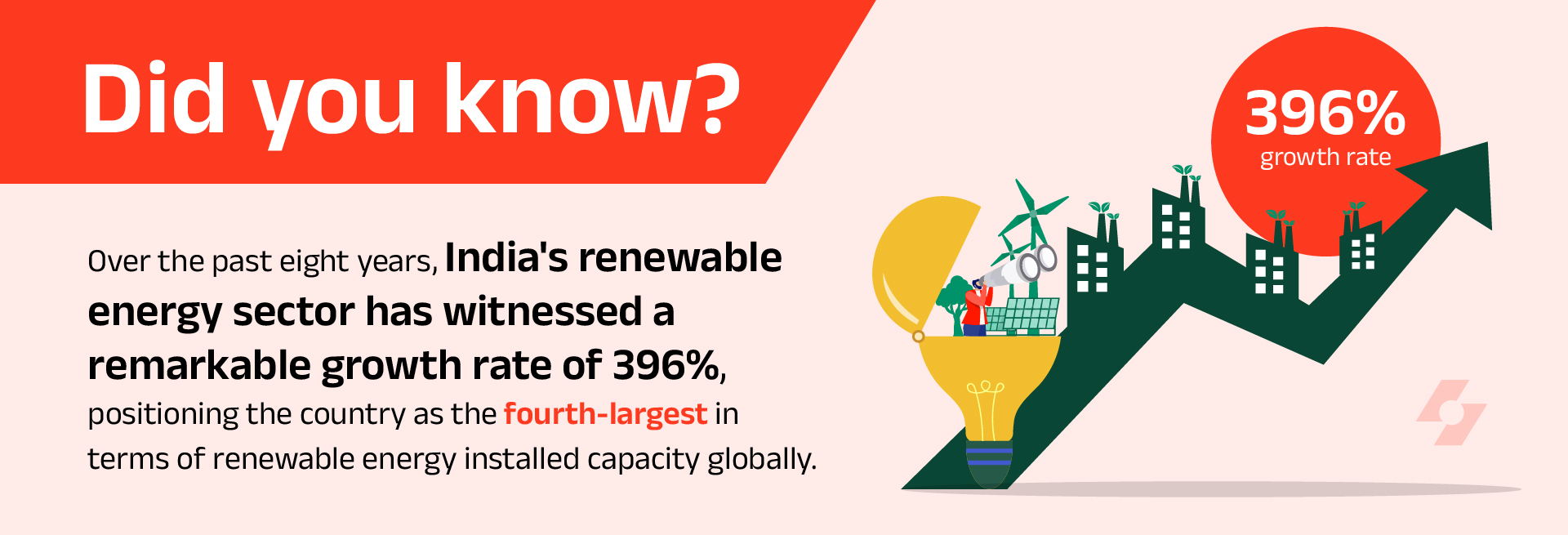
Green Energy in India: Current Status and Future Potential
India is the world’s third-largest electricity consumer and producer of renewable energy. As of October 2024, 46.3% of India’s total energy capacity, amounting to 203.18 gigawatts (GW) out of 452.69 GW, comes from renewable sources.
The country has set ambitious goals to further expand its green energy footprint. By 2030, India aims to achieve 500 GW of non-fossil fuel energy capacity. By 2070, India is aiming to achieve the net zero target.
To reach this target, different companies are making significant investments. For instance, NTPC, India’s state power company, plans to invest over USD 23 billion in renewable energy projects in Madhya Pradesh, focusing on solar, wind, and hydroelectric power.
Private sector companies are also contributing to this green energy push. These efforts highlight India’s commitment to a sustainable energy future, leveraging its abundant natural resources and technological advancements to reduce the reliability of fossil fuels and fight climate change.
What are the Economic Benefits and Corporate Profitability of Green Energy?
Using green energy in India has several economic benefits and also corporate profitability. They are:
Renewable energy, especially solar and wind, is becoming cheaper than coal and gas. This helps industries and businesses save money on electricity bills.
Using renewable energy reduces India’s need to buy coal and oil from other countries, saving money and strengthening the economy.
Investing in green energy helps the environment, which attracts more investors and businesses looking for eco-friendly solutions.
- Investment and Business Growth
Many companies are investing in green energy, bringing money into India. This helps businesses grow and creates new opportunities.
Companies producing solar panels and wind turbines make profits by selling their products. Businesses using green energy also spend less on power, increasing their earnings.
Green energy projects like solar and wind farms create many jobs in manufacturing, installation, and maintenance. This helps people earn a living and improves the economy.
What are the Challenges and Solutions in Adopting Green Energy?
Adopting green energy, like solar and wind power, is essential for a cleaner planet. However, there are challenges to overcome, each with its solution.
| Challenges |
Solutions |
| Solar and wind energy depend on the weather, so they do not produce the same amount of power all the time. |
Developing better battery technologies can store extra energy when it is sunny or windy, ensuring a steady supply even during unfavourable weather conditions. |
| Setting up solar panels and wind turbines can be expensive at first. |
Governments and companies can offer financial help, like tax breaks or special funds, to make it more affordable for people and businesses to start using green energy. |
| Our current electricity grids are designed for traditional energy sources and might struggle to handle energy from renewables. |
Upgrading the grid with smart technology can help manage energy from various sources, ensuring a steady and reliable supply. |
| Some people might worry about having wind turbines or solar farms near their homes. |
Educating communities about the benefits of green energy and involving them in planning can address concerns and gain support. |
By addressing these challenges with thoughtful solutions, we can make green energy a bigger part of our lives.
Subscribe to our newsletter
The Future of Green Energy: Trends to Watch
The world is moving towards green energy faster than ever. Here are some trends that will shape the future:
- Smart Wind and Solar Power: Wind turbines are getting smaller and quieter, making them useful in cities. Solar panels on water bodies are improving efficiency.
- Better Energy Storage: New high-capacity batteries and hydrogen fuel cells store energy for later use, even when the sun is not shining or the wind is not blowing.
- Carbon Capture Technology: Factories can now capture carbon dioxide before it goes into the air and store it safely underground, reducing pollution.
- Electric and Self-Driving Cars: EVs are improving with better batteries, faster charging, and self-driving technology to reduce fuel waste. Smart charging stations powered by solar and wind energy are also being built.
- Eco-Friendly Farming: Farmers use vertical farming to grow crops in small spaces. Drones and sensors help save water and fertilizers. Lab-grown meat reduces pollution from animal farming.
- Advanced Recycling: AI-powered machines sort plastic, paper, and metals quickly, helping recycle materials efficiently.
- Green Buildings: New buildings use smart technology to control lighting, heating, and cooling automatically. Materials like bamboo and recycled steel reduce environmental impact.
Conclusion
Switching to green energy is not just about protecting nature; it also creates jobs, lowers electricity costs in the long run, and makes India more energy-independent. While challenges exist, smart solutions like better storage, improved grids, and government support are making renewable energy more reliable.
If India continues investing in green energy, it can become a leader in sustainability, providing a healthier and brighter future for all. The journey towards green energy may take time, but every step counts in building a cleaner and stronger nation.
